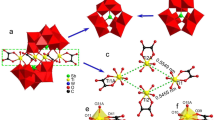Abstract
From the reaction or Mo2Cl6(THF)3 with excess of NaO2CPh and PEt3 in THF three types of crystals have been obtained and recrystallized in CH2Cl2. They are brown compound Mo2(O2CPh)6(PEt3)2·2CH2Cl2 (1), yellowβ-Mo2(O2CPb)4 (2), and black Mo4O6(O2CPh)6(PEt3)2.CH2Cl2 (3). When a strict ratio of MO2Cl6(THF)3:NaO2CPh = 1:2 was applied, Mo2(O2CPh)4(THF)2, (4) was the only compound separated from the THF reaction mixture. Their structures have been determined by X-ray crystallography. There are three coordination modes of benzoate in 1: bridgingη 2-O2CPh, bridgingη 1-O2CPh and terminal O2CPh groups. Compound 2 is chemically well known, but was found to pack differently from the previously reported structure. Mo4O6(O2CPh)6(PEt3)2·CH2C12 (3) is a mixed-valence Mo (IV, V) tetranuclear compound in a butterfly arrangement. A molecule of 4 is actually a MO2(O2CPh)4 molecule with two THIF molecules axially coordinating to the molybdenum atoms. The crystallographic data for these compounds are as follows: 1, triclinicPl witha = 11.612(3) Å, b = 11.970(2) Å,c=12.135(3) Å,α=95.55(2)°,β=117.51(2)°,γ98.84(2)°,V=l450.8(7) Å3,Z=1,R=0.0673, and R w ,=0.0936; 2, monoclinicP21/n witha = 14,437(2) Å,b=5.6168(7) Å,c=15.979(3) Å,β=93,93(l)°,V=1292.7(4) Å3,Z=2,R=0.0217, and Rw=0.0352; 3, trigonal (hexagonal setting)R3¯ witha=28.83(4) Å,c=44.98(2) Å,V=323570(10) Å3,Z=18,R=0.067, andwR2=0203; 4 monoclinicP21/c witha=9.456(4) Å,b=17.757(8) Å,c=10.887(3) Å,β=109.63(2)°,V=1722(2)Å3 Z=2,R=0.0330, andR w = 0.0451.
Similar content being viewed by others
References
F. A. Cotton, J. Su, Z. S. Sun, and H. Chen (1993).Inorg. Chem. 32, 4871.
I. W. Boyd and A. G. Wedd (1976).Ausi. J. Chem. 29, 1829.
K. Jansen and K. Dehnicke (1987).Natufrosch. 42b, 1097.
F. A. Cotton, M. Extine, and L. D. Gage (1978),Inorg. Chem. 17, 172.
F. A. Cotton and W. Wang (1984).Inorg. Chem. 23, 1604.
F. A. Cotton and S. M. Morehouse (1965).Inorg. Chem. 4, 1377.
D. J. Darensbourg, R. L. Grey, and T. Delord (1985).Inorg. Chim. Acta 98, L39.
B. Kamenar, B. Korpar-Čolig, and M. Penavić (1981).J. Chem. Soc., Dalton Trans. 311.
Author information
Authors and Affiliations
Rights and permissions
About this article
Cite this article
Cotton, F.A., Su, J. Mo2(O2CPh)6(PEt3)2, the second example of bridging Y11-02CR for dimolybdenum (III) compounds. J Clust Sci 6, 39–59 (1995). https://doi.org/10.1007/BF01175835
Received:
Issue Date:
DOI: https://doi.org/10.1007/BF01175835




